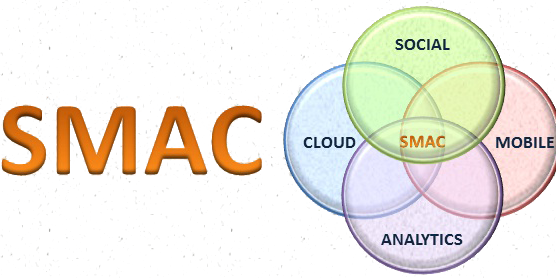Every decade or so, the IT industry has witnessed new innovations in computing which have changed the way IT services are delivered to businesses and end users alike. After the mainframe era, mini – computing era, personal computers and client – server era, and the Internet or “Web” era, we are now entering the next era – the SMAC era.
SMAC stands for Social Media, Mobile, Analytics and Cloud computing technologies, and together promises to be the new change agent in enterprise IT. When implemented as a combination, these technologies serve as a synergetic solution for digitally transforming an organization for the future of business.
Social technologies allow for the rapid creation and sharing of knowledge over social networks, enhancing collaboration and information distribution. People, widely regarded as the most valuable asset for any organization, drive the knowledge sharing, and facilitate in the dissemination of that knowledge to drive business results.
What social media accomplishes is the ability for businesses to reach a multitude of those likely to view the message. Businesses can refine marketing campaigns that are more in tune with each section of common attitudes in the intended audience. Because people choose which businesses they follow, these businesses can address similar concerns or needs of their consumers via a quick social response.
Mobile technologies are continuing to change, evolve and reshape the technology landscape. The growth in smart and “smarter” devices is revolutionizing the way we are connected. Users are able to access information anytime, anyplace with ease. Mobile devices let consumers reach internet services in places unforeseen a decade ago. Businesses are directly marketing to mobile devices, with individual applications that run on almost all platforms, to help drive sales.
Analytics goal is to create and deliver information that is relevant, understandable and actionable. These are great tools for businesses and closely aligned to the other half of this technology – “big data”. It is no longer confined to being SMART – specific, measurable, attainable, relevant and time-bound, but rather SMARTER which also includes evaluating and refining the process itself.
In websites, for example, this is used to capture traditional information such as, visitor data, navigation patterns, usage patterns, what users are clicking, what they are buying, etc. This has now evolved to logs and activities which go much deeper than potential sources, to include external data sources such as financial reports, credit histories, and other such big data. This is allowing businesses to see what is happening in real-time and focus on key areas of development and improvement of their processes, and ultimately, drive customer sales and satisfaction efforts.
Cloud computing / technology is the linchpin of the SMAC stack. This is so because, now and in future, it will be at the core of consuming and offering your business to customers and consumers alike. More specifically, cloud computing allows the requesting, provisioning and consuming of vendor services more immediately. The key benefit that businesses derive is avoiding purchase of expensive infrastructure, hardware, and software, in exchange for remote data and software. Employees become more productive and consumers are better educated. Cloud computing offers several benefits to all kinds of businesses, if managed well to avoid failure or conflict.
SMAC is becoming a standard requirement for businesses because of the value that each area adds to the business, yet combined, become a natural and more potent solution. Fundamentally, using SMAC elements together leads to immediate and sustainable value in your business!








